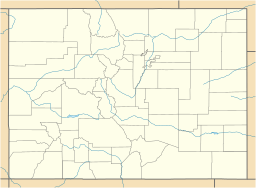Central Colorado volcanic field facts for kids
Quick facts for kids Central Colorado volcanic field |
|
|---|---|
| Highest point | |
| Geography | |
| Location | Park County, Colorado, United States |
| Geology | |
| Age of rock | late Eocene/Oligocene (38–29 Ma) |
| Mountain type | Volcanic field |
The central Colorado volcanic field (CCVF) is a large area in Park County, Colorado, where many volcanoes erupted a long time ago. It's located in the southern Rocky Mountains. This volcanic area covered a huge space, shaped like a triangle.
It stretched from the Sawatch Range all the way to the northern Sangre de Cristo Range and the Wet Mountains. It also reached northeast to the southern Front Range, south of Denver. The eruptions from at least ten different volcanic centers or calderas covered about 22,000 square kilometers (8,500 square miles).
This volcanic field is next to the San Juan volcanic field in the west. The rocks and other materials from these eruptions are very old. They date back to the late Eocene and early Oligocene periods, which was about 38 to 29 million years ago.
Contents
Gold and Building Stone: How Volcanoes Helped Colorado
The rocks from the Central Colorado Volcanic Field are important for more than just geology. They hold valuable metals and gems.
The Cripple Creek Gold Rush
One famous example is the volcanic area at Cripple Creek. This place became very famous for a huge gold rush that started in 1890. A gold rush is when many people quickly move to an area hoping to find gold.
By 1900, more than 500 mines were dug in the Cripple Creek area. The population there grew to over 35,000 people! Even today, people still mine for gold in open pits at Cripple Creek.
Castle Rock Stone Quarries
Another important rock from this volcanic field is called Wall Mountain Tuff. This rock was spread far and wide by the ancient eruptions. You can find it near the town of Castle Rock. This is more than 90 miles (145 kilometers) from where the eruption happened!
People in Castle Rock called this stone Castle Rock Rhyolite. Starting in 1872, it was dug up from quarries and used for building. It became a popular material for buildings in cities like Denver and Colorado Springs.
The quarries were very important for Castle Rock's economy. In 1900, they produced enough stone to fill 1,800 train cars each year. They also employed up to 100 workers. While the biggest operations stopped in 1906, at least one quarry was still working in 2013.
Cool Volcanic Spots
The Central Colorado Volcanic Field has several interesting geological features. Many of these are calderas, which are large, bowl-shaped hollows formed when the ground collapses after a volcanic eruption.
Here are some of the notable areas within the field:
| Name | Elevation | Coordinates | Age |
|---|---|---|---|
| Thirtynine Mile | - | 38°49′56″N 105°33′16″W / 38.8322°N 105.5544°W | |
| Grizzly Peak Cauldron | - | 39°06′N 106°36′W / 39.1°N 106.6°W | |
| Mount Aetna Cauldron | - | 38°36′N 106°18′W / 38.6°N 106.3°W | |
| Bonanza Caldera | - | 38°17′42″N 106°06′00″W / 38.295°N 106.1°W | |
| Marshall Creek Caldera | - | 38°24′N 106°18′W / 38.4°N 106.3°W |


